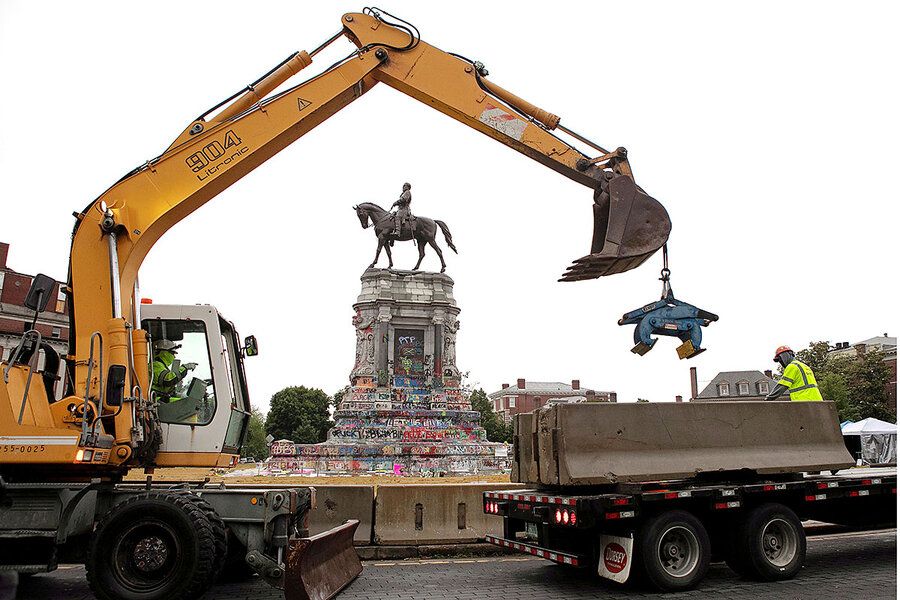Can Richmond imagine a future without Robert E. Lee?
Loading...
| Richmond, Va.
On June 4, Virginia Gov. Ralph Northam announced plans to remove the statue of Robert E. Lee that has towered over Richmond for 130 years. Soon after, the city committed to removing four other Confederate statues from Monument Avenue.
Around the world there has been a wave of renewed scrutiny over symbols that many say preserve a legacy of racism. From Birmingham, Alabama, to Bristol, England, statues of former Confederate generals and slaveholders are coming down. Meanwhile, American institutions from NASCAR to the Navy have banned displays of the Confederate battle flag.
Why We Wrote This
Monuments reflect the society in which they’re made, a professor says of the symbols of the Confederacy being taken down across the country. It says something to keep them up; it says something to take them down.
For some experts familiar with past campaigns to remove such monuments, the past few weeks mark a turning point.
“The cliché is that history is written by the winners, and these were not the winners,” says Gabriel Reich, a professor at Virginia Commonwealth University in Richmond. “The Confederates lost the war and lost the dream of an independent slave republic. But they won the peace.”
Righting what many see as a historical wrong is a sign that things have changed, says James “J.J.” Minor, president of the Richmond branch of the NAACP.
“Richmond is now getting it,” he says. “We’re moving in the right direction, plain and simple. What was will never exist again.”
James “J.J.” Minor works in Shockoe Bottom, an upscale restaurant district in Richmond, Virginia, and once a center of America’s slave trade. Driving across town from his office at Main Street Station he could pass a former slave jail, Confederate iron works, the White House of the Confederacy, and titanic statues to Robert E. Lee, Stonewall Jackson, J.E.B. Stuart, and Jefferson Davis – marching in a line down Monument Avenue.
It’s a simple seven-mile loop. He could drive it in less than a lunch break.
As a Richmond native, Mr. Minor knows his Virginia history. As president of Richmond’s branch of the NAACP, he also knows how painful that history can be. So watching the city’s leaders commit to removing symbols that memorialize racism, in his opinion, is a sign of long-overdue progress.
Why We Wrote This
Monuments reflect the society in which they’re made, a professor says of the symbols of the Confederacy being taken down across the country. It says something to keep them up; it says something to take them down.
“It’s a new beginning,” he says. “I think it’s a long time coming, as the old folks used to say. Removing those Confederate monuments – it means a lot.”
On June 4, Virginia Gov. Ralph Northam announced plans to remove the statue of Lee that has towered over Richmond for 130 years. Soon after, the city government committed to removing the other four Confederate statues from Monument Avenue.
Elsewhere in the South and around the world, there has been a wave of renewed scrutiny over symbols that many say preserve a legacy of racism. From Birmingham, Alabama, to Bristol, England, people have removed – or announced plans to remove – statues of former Confederate generals and slaveholders. Meanwhile, American institutions from NASCAR to the Navy have banned displays of the Confederate battle flag. Last week, the Senate Armed Services Committee voted to amend the annual National Defense Authorization Act to create a commission tasked with renaming military installations named after Confederate figures. The full Senate still needs to vote on the bill, which President Donald Trump has said he will veto.
For some experts familiar with past campaigns to remove such monuments, the past few weeks mark a turning point. Just three years ago, white nationalists marched en masse when the city of Charlottesville attempted to take down a statue of Lee. Though Governor Northam’s order is being challenged in court, resistance today has abated.
Lecia Brooks, chief workplace transformation officer at the Southern Poverty Law Center (SPLC), attributes that shift to a major change in public opinion, similar to that seen with Black Lives Matter.
“In each successive moment people have been saying the same things: that this is representative of anti-Black racism or white supremacy or systemic racism. But people seem to get it now,” she says. “Those kinds of huge societal shifts say a lot and really do a lot to begin to dismantle these racist structures that we’ve lived with and we just go along with because they’ve just always been.”
“These were not the winners”
The SPLC first began to study Confederate monuments following the mass shooting at the Mother Emanuel A.M.E. Church by a white supremacist in Charleston, South Carolina, five years ago today. Since then, says Ms. Brooks, they have documented more than 1,800 “active monuments” to the Confederacy – such as school names, statues, and memorials.
According to lore, she says, these monuments rose up soon after the Civil War to commemorate those who fought for the “Lost Cause” of the Confederacy. The reality, says Benjamin Forest, a professor at McGill University in Quebec, is that most were constructed in two waves: from 1890 to 1910 and from 1950 to 1970.
The first period, he says, came along with Jim Crow in the South and the second was a response to the civil rights era. In both, says Professor Forest, Southerners used Confederate monuments to rewrite the history of the Civil War and assert power over African Americans.
“The cliché is that history is written by the winners, and these were not the winners,” says Gabriel Reich, a professor at Virginia Commonwealth University in Richmond. “The Confederates lost the war and lost the dream of an independent slave republic. But they won the peace.”
Winning the peace, says Professor Reich, meant maintaining racial subjugation after the war ended and successfully reframing the Civil War around states rights and honor. Confederate monuments, he says, were crucial to both aims – embodying a mythic Confederate heritage into the future.
In turn, those displays marginalized the heritage of most African Americans, for whom the Antebellum South is synonymous with slavery and oppression, says Ms. Brooks. If anything, she says, they’re a sign of how little things have changed.
“The continued existence of the monuments continue the political statement that the people who insist these remain up still call the shots,” says Professor Reich.
“People seem to get it now”
This time may be different.
When Richmond’s Lee statue went up in 1890, around 150,000 people flocked to watch the ceremony, says Professor Reich. Former Confederate soldiers addressed the crowd. The now-famous Confederate battle flag was everywhere.
Now the statues on Monument Avenue have become a rallying point for the recent protests in Richmond. Mr. Minor, president of Richmond’s branch of the NAACP, has joined thousands of others who gathered around the statue of Lee to decry police brutality and systemic racism.
“It was like an ecumenical movement – a spiritual movement,” he says of a protest he attended on Monument Avenue. “Folks were walking hand in hand talking, shaking, hugging, loving, laughing – both Black and white, rich and poor and the in-between, all coming together to say enough is enough.”
The change in public opinion surrounding the monuments, says Ms. Brooks, comes in part from the momentum of past movements. It’s also, she says, a product of increased public awareness of white supremacy – spurred in large part by the 2017 Unite the Right Rally in Charlottesville.
“People are beginning to understand – or begin to more fully understand – what it means when we say a white supremacist culture or anti-Black racism,” she says. “So understanding or embracing those concepts more deeply has allowed them to make the connection between these symbols of the Confederacy and some of the ways that society upholds systemic racism.”
“People seem to get it now,” she says.
Notwithstanding, not everyone in America is ready to pull down the statues, as shown by court challenges and threats of presidential veto. An early June poll from Morning Consult found more support for keeping the monuments up than taking them down, though that number has eroded since Charlottesville. Some 44% of Americans support keeping them in place, down from 52% in 2017.
How important are symbols?
Such pushback doesn’t surprise Mr. Minor. After so many years, he’s adjusted to the challenges that often accompany being Black in the South, he says. One time, he says, a police officer pulled a gun on him on the side of the road. Another time, he was strip-searched near public housing. He didn’t know why either time.
“It’s tough being a Black man in America,” says Mr. Minor.
Even if all the Confederate monuments in Richmond and beyond are taken down, he says, more work will remain. After all, they’re only symbols.
But symbols can matter, says Professor Forest. Monuments, in his opinion, reflect the society in which they’re made. It says something to keep them up; it says something to take them down.
It will mean something to Mr. Minor if these statues are moved. He doesn’t think America has a “balance of history,” and he thinks the country needs it. Righting what many see as a historical wrong is a sign that things have changed, he says.
“Richmond is now getting it,” he says. “We’re moving in the right direction, plain and simple. What was will never exist again.”










